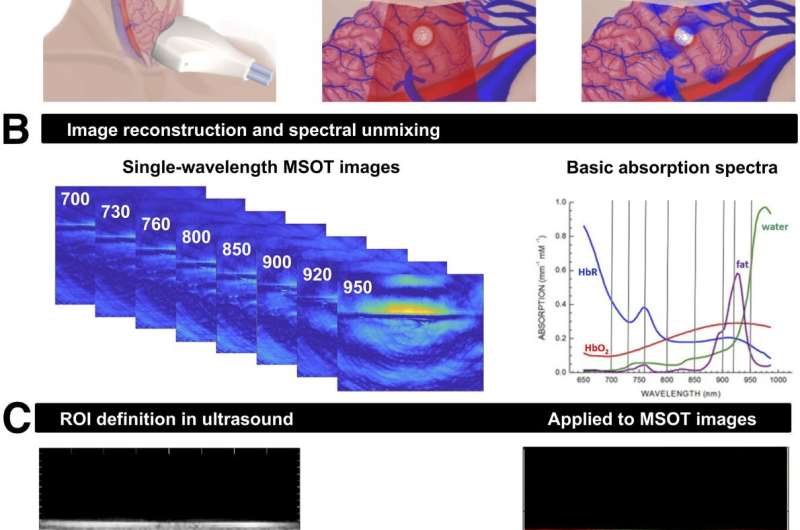Principles of clinical MSOT of thyroid. (A) Scheme of examination of thyroid gland with handheld hybrid MSOT/ultrasound system (left). Patients with thyroid nodules, healthy individuals and Graves’ disease patients were scanned in a reproducible setup. Optoacoustic imaging is based on absorption of irradiated laser pulses within tissue (middle), followed by thermoelastic expansion and induction of ultrasound waves that can be detected with handheld detector (right). (B) In a first step, MSOT images are acquired for single wavelengths (left). Spectral unmixing, based on specific absorption spectra of different tissue constituents (right), allows assessment of functional parameters such as HbR, HbO2, fat content, and water content. (C) Transversal ultrasound image of thyroid gland and surrounding tissue allows exact localization of anatomic structures (left). ROIs drawn on ultrasound images were transferred to coregistered pseudo colorcoded averaged MSOT images (here, HbT) for visual and quantitative analysis (right). Credit: SNMMI
A combination of multispectral optoacoustic tomography (MSOT) and ultrasound has been used to noninvasively characterize a range of thyroid disorders, according to new research published in the October issue of The Journal of Nuclear Medicine. By providing a semiquantitative analysis of functional parameters and tissue characterization, the novel noninvasive imaging technique can provide novel biomarker information for initial evaluation and differential diagnosis of thyroid disorders.
Thyroid disorders, including autoimmune disease (Graves' disease) and thyroid nodules, are common worldwide. The American Thyroid Association estimates that 12 percent, or 20 million, Americans have some type of thyroid disorder.
"Currently, evaluation and risk stratification methods for thyroid disorders include hormone testing, high-resolution ultrasound, scintigraphy and invasive procedures—fine needle aspiration biopsy and thyroidectomy," said Wolfgang Roll, MD, physician at the Department of Nuclear Medicine/University Hospital Münster. "Imaging with MSOT, which detects ultrasonic waves generated by the expansion of tissue illuminated with ultrashort laser pulses, has proven valuable in vascular imaging, inflammatory bowel diseases and oncology. Our study set out to evaluate if hybrid MSOT/ultrasound imaging might provide new biomarkers to further assess risk patterns for individual thyroid nodules without the need for invasive procedures."
Eighteen patients were included in the study: three patients with Graves' disease, three healthy volunteers, nine patients with benign thyroid nodules and three patients with malignant thyroid modules. For the comparison of Graves' disease with healthy thyroid tissue, 14 thyroid lobes (six with Graves' disease and eight with healthy tissue) were imaged with MSOT/ultrasound. To compare thyroid nodules, a total of 16 nodules (13 benign and three malignant) were imaged with MSOT/ultrasound. All patients also underwent a routine clinical thyroid evaluation, following international guidelines.
MSOT images were reconstructed, and several functional biomarkers and tissue parameters were analyzed, including deoxygenated hemoglobin, oxygenated hemoglobin, total hemoglobin, saturation of hemoglobin, fat content and water content. Regions of interest were drawn on ultrasound images and transferred to the corresponding coregistered MSOT images. Statistical analyses were then performed.
MSOT/ultrasound imaging found significantly higher deoxygenated hemoglobin and total hemoglobin, as well as significantly lower fat content, in Graves' diseases lobes as compared with healthy controls. When comparing thyroid nodules with MSOT/ultrasound, malignant thyroid nodules showed significantly lower saturation of hemoglobin and lower fat content than benign nodules. The authors noted that hybrid MSOT/ultrasound was easily applicable to patients with thyroid diseases and sufficiently reproducible.
"Optoacoustic imaging is a new opportunity to employ optical imaging for deep tissue analyses with potential clinical applications in various benign and malignant disease," Roll stated. "Our study has shown that hybrid MSOT/ultrasound can assess changes in tissue composition in thyroid disorders by providing semiquantitative functional parameters noninvasively. With additional preclinical and clinical translational research, these technical developments can help to improve diagnostics and assessment of therapy response in the future."
More information: Wolfgang Roll et al, Multispectral Optoacoustic Tomography of Benign and Malignant Thyroid Disorders: A Pilot Study, Journal of Nuclear Medicine (2019). DOI: 10.2967/jnumed.118.222174
Journal information: Journal of Nuclear Medicine
Provided by Society of Nuclear Medicine and Molecular Imaging






















